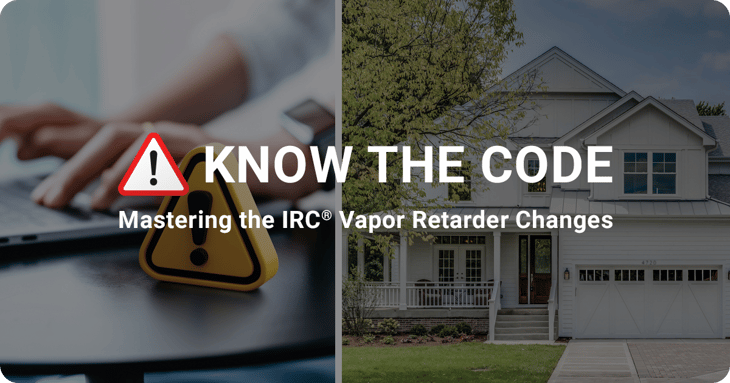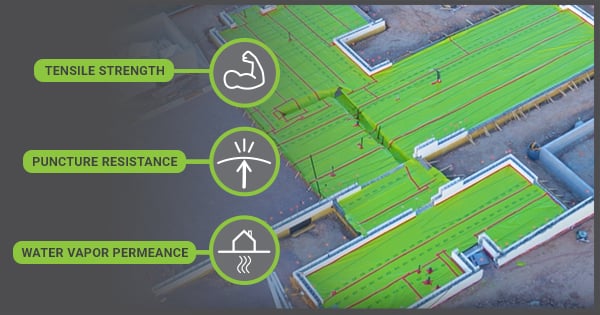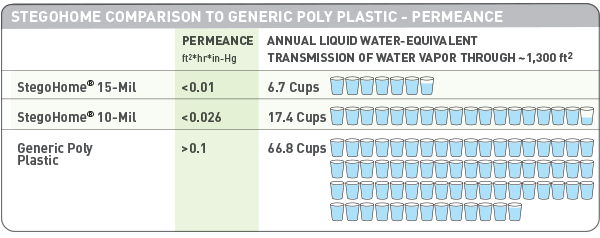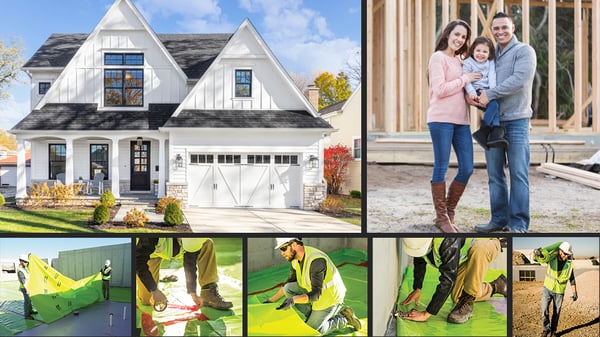Your Guide to Navigating the IRC Building Code Changes to Vapor Retarders
Strategies for Material Selection, Project Planning, and Compliance Under the 2021 International Residential Code* 
With more states and jurisdictions adopting the 2021 International Residential Code (IRC), is your jurisdiction one of them or soon to be? The 2021 code introduces significant updates aimed to enhance moisture protection in residential construction. These changes, particularly the shift to a new baseline for water vapor protection beneath concrete floor slabs in Section R506.2.3 Vapor Retarder, represent a pivotal evolution in building practices emphasizing the importance of improved moisture management to enhance a home's structural integrity and air quality. To meet code requirements*:
- Vapor retarders placed between concrete floor slabs and the base course or subgrade must have a minimum thickness of 10-Mil.
- Vapor retarders must conform to ASTM E1745 Class A requirements, which helps ensure their performance and durability for residential applications.
- Joint overlaps must be at least 6 inches, helping achieve some minimum installation consistency.
Note: Exceptions exist for unheated structures, small storage rooms, exterior flatwork, and specific local site conditions, offering flexibility where appropriate.
It’s crucial to understand what’s required, where it is in effect, and why it is a significant step forward to enhancing home quality and adding value to homeowners, without a significant impact on the upfront cost of the home.
Understanding the Implications of ASTM E1745 – The Gold Standard
For homebuilders, code officials, and others who serve the residential construction landscape, a bump from 6 to 10-mil minimum thickness is likely well-understood conceptually. However, reference to ASTM E1745 and the Class A requirement may be somewhat unfamiliar. Let’s dive into what ASTM E1745 is and why it is such a useful performance standard for membranes to meet in this application, regardless of whether where you build has (or ever will) adopted the 2021 IRC.
ASTM (American Society for Testing and Materials) E1745 is the Standard Specification for Plastic Water Vapor Retarders Used in Contact with Soil or Granular Fill Under Concrete Slabs. This standard requires products undergo conditioning testing designed to simulate in-service (below-slab and installation) conditions, and it classifies vapor retarders based on their:
- Tensile Strength
- Puncture Resistance
- Water Vapor Permeance Ratings

A code update to reference ASTM E1745 should not be too surprising. After all, when it comes to this specific below-slab application, incorporating membranes that meet ASTM E1745 has been a published best practice for vapor retarder performance across the industry, including ACI 332 Guide for Residential Floor Slab Construction and EPAs Guide to Moisture Control.
Part of the utility of ASTM E1745 is it ensures materials that test to and meet this standard not only meet a minimum permeance threshold but an appropriate and necessary level of strength to ensure durability. This is different than how the residential industry (and the code) approach vapor control in walls, where a Class I, II, or III vapor retarder is referenced (or none in some Climate Zones). Vapor retarders beneath concrete slabs are evaluated and selected very differently, and the 2021 IRC code updates are helping make that important distinction clearer.
What is more, ASTM E1745 outlines mandatory conditioning tests which are designed to simulate the below-slab (as well as crawl space) environment in service. In other words, materials which test to and meet ASTM E1745 offer a level of assurance that they resist deterioration that could impact their ability to effectively impede water vapor transmission for the life of the slab and home.
It is the specific testing requirements within ASTM E1745, particularly conditioning testing related to material longevity, that brings to light concerns with using generic poly sheeting in the below-slab application.
ASTM E1745 necessitates a higher level of raw material quality (e.g., the resins) and film engineering to meet the performance thresholds outlined in ASTM E1745 and maintain consistency from one produced vapor barrier roll to the next. Generic poly sheeting, however, is generally made up of high percentages of reprocessed and recycled resins. This means polymer chains break up, and there is often a wider range of inconsistencies in performance between produced rolls – especially the important performance characteristics suitable for a below-slab application.
Bottom line: generic, commodity poly sheeting (6, 10, or higher mil thicknesses) does not meet ASTM E1745. It may be appropriate for many other applications, including in some cases vapor control in other parts of the building enclosure. But, in general, the construction industry has moved past low-quality poly sheeting as a durable, long-term solution for effectively controlling vapor below-slab, at the first side of the home.

Elevating Moisture Protection Nationwide with StegoHome
Builders and homeowners looking to meet or exceed the 2021 IRC vapor retarder requirements can do so with StegoHome Below-Slab Vapor Protection. Engineered using innovative multi-layer technology and only high-grade resins, StegoHome provides reliable moisture protection, durability, and longevity beneath concrete floors, regardless of building location or Climate Zone.
Part of the value of StegoHome is that it is specifically designed for new residential footprints. Lightweight roll size options bring a unique level of installation ease and reduced waste for builders and trade contractors. What is more, StegoHome offers a first-of-its-kind Life of the Building™ Warranty, offering homebuilders and homeowners unmatched peace of mind.
As a solution from Stego, the industry-leader in below-slab vapor protection, choosing StegoHome also offers homebuilders, code officials, raters, architects, and trades access to unmatched support from Stego experts.
Perhaps the best news of all – specifying or selecting StegoHome represents tremendous value for new homes. The residential industry is continuing to evolve to emphasize proven building science approaches that contribute to durability, comfort, health, and safety. Often, these approaches also represent a bump in up-front material or installation cost but provide significant net benefits over the life of the home. This is true when it comes to StegoHome – what amounts to pennies per square foot in initial material can be easily justified (or potentially made up) in benefits to home performance, reduced ownership costs, or simple peace of mind. In fact, homebuilders have the opportunity to leverage their use of StegoHome as a value-add to their prospective customers.
Strategies for Seamless Integration of Referenced Standards
Transitioning to the new IRC requirements necessitates thoughtful planning and execution. Our hope is to offer actionable insights for construction professionals, focusing on material selection, project planning, and compliance strategies.* Emphasizing best practices and innovative approaches can facilitate a smooth adoption process, enabling builders to enhance the quality of their projects while adhering to the latest building codes. Recognizing the importance of comprehensive support, we’re dedicated to providing resources and initiatives designed to help the construction community prepare to meet and exceed evolving code minimums:
- Continued Education: designing and constructing new homes takes a team —architects, builders, trades, code officials/inspectors, consultants, suppliers, etc. Stego offers continuing education opportunities to help bring everyone up-to-speed on the evolution of vapor protection beneath concrete floors and benefits of incorporating better product solutions.
- Tailored, Local Expert Support: local building codes and new home construction varies – foundation types, soil threats, size, budgets, etc. - depending on where you build, but Stego’s team of local experts are available to navigate your unique projects. Whether it is a single custom home or a new large development, we can help evaluate product solutions to help you find the right fit.
- Installation Training: like any building enclosure system, effective installation is an important consideration. We have product installation tools, training, and support for builders and trades. Not only helping to achieve an effective installation for your build, but also providing best practices on maximizing efficiency and reducing material waste.
- Inspection and Compliance*: StegoHome makes it easy for inspectors, raters, and others to ensure code compliance with clear visual markings indicating that the product meets ASTM E1745 Class A. Additionally, StegoHome often contributes to compliance with residential green building certifications (e.g., NGBS), with documentation and project team support available.

Leading the Charge in Advanced Moisture Protection
The changes within the 2021 IRC vapor retarder requirements underscore a collective move towards creating more resilient and healthy homes. As the residential construction industry adapts to these changes, Stego remains at the forefront, offering products that not only meet but exceed the code requirements. With a commitment to innovation and quality, StegoHome is a solution poised to support the residential market through this transition, helping to ensure homes are built to last and protect against the challenges of moisture.
*The information provided in this article is for general information purposes only and does not and is not intended to constitute legal advice or design guidance. The information may not constitute the most up-to-date legal or other information and may differ from the applicable code, laws, regulations, and/or other requirements of your locality. You should not act or refrain from acting on the basis of this information without seeking legal or other professional advice.

Written by Tom Marks
Tom Marks is the Business Development Project Manager with Stego Industries, LLC. He has been with Stego since 2007, serving many years as the Rocky Mountains Regional Manager. Now, his focus is geared toward vapor barrier solutions for new and existing homes as the Product Manager of the StegoHome and StegoCrawl brands. In addition, Tom serves as Sustainability Manager, overseeing Stego’s leadership in holistic product and corporate sustainability. Tom enjoys working with a wide range of project team members and customers to incorporate effective sub-slab vapor protection and create healthy, sustainable homes and buildings.
- Stego (26)
- StegoCrawl (24)
- Stego-Awareness (17)
- StegoHome (15)
- Case Studies (14)
- StegoCrawl-Consideration (12)
- StegoCrawl-Awareness (11)
- Customer Stories (9)
- Stego-Consideration (9)
- Pango (8)
- StegoHome-Consideration (8)
- Beast (7)
- How to Install (7)
- StegoHome-Awareness (7)
- Drago (5)
- Pango-Awareness (5)
- Beast-Awareness (4)
- Beast-Consideration (3)
- Drago-Awareness (3)
- Pango-Consideration (3)
- Stego IQ (3)
- Drago-Consideration (2)
- StegoCrawl-Decision (2)
Popular Posts
Stay Connected.
Enter your email below.








Post Comments